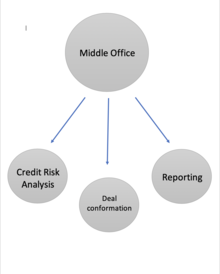User:Pkyaw/sandbox
Original
The middle office comprises departments of a financial services company that manage position-keeping (i.e. control representation of transactions within transaction-registering system of a company). These divisions make sure these transaction representations properly capture profit flows given the technological resources. The middle office is usually part of operations and finance divisions including product control, which normally is also in charge of settlement. It draws on the resources of both the front and the back offices. Due to their critical role, the middle office always acts in tandem with the front office work on open markets. Broadly speaking, middle office includes roles that affect either side (invest, finance, hedge, insure) of the balance sheet of the business.
Edited
Middle Office

Middle office is a term that refers to a team of employees working in a financial services institution whose significant roles and responsibilities involve managing risks, calculating losses and profits. These people also work in the information technology departments of different organizations. Financial services institutions are rationally divided into three sections which involve the front, the middle and the back office. The front office is composed of various employees such as the corporate finance representatives and the sales personnel. The middle office is made up of the risk managers and the information technology managers who play vital roles in managing various forms of risk and future uncertainties and maintain and protect the information resources of a financial service institution respectively[1]. The back office is composed of the human resource managers, office managers, and the customer care representatives who play fundamental roles in providing support, administrative and payment services to customers. Generally, the role of back and middle office involves non-revenue generating operations which are directly related to risk management and ensuring proper execution of transactions[2].
The middle office plays numerous roles in the financial services organizations and the investment banking sectors. These people ensure that deals negotiated during financial transactions are processed, booked and fulfilled. They also manage numerous global agreements concerning business transactions, risk management, and profit and losses. Lastly, they also play significant roles in ensuring that needed defiant documents are completed according to the prior agreements. The information technology middle office is also important in the designing of software that is applied in the trading strategies. They are also involved in the managing of contracted software systems such as Reuters 3000[3] and Bloomberg that are necessary for trading. The information technology middle office assists both the back and front offices by monitoring and capturing the essential market and marketing information.
Background
The history of the term middle office dates back to 1868 during the origin of foreign exchange and investment baking[4]. This was also the period when gold and silver were used as the standard measure of the global monetary system, and countries used these two metals when trading with other nations. During this period the term middle office was used to refer to those employees working in the banking and financial institutions whose primary role was to calculate the profits and losses realized after trading with a foreign nation[5]. But the meaning of this term changed during the beginning of the First World War after the abolition of gold and the introduction of paper money in the international market[5]. The term investment banking originated in America while in Britain this term was referred to as merchant’s bank. The significant roles of these investment banks were to enable government agencies and firms to raise money through issuing and selling of acquisitions. These banks also played intermediaries role among trading customers. And advised both large, medium-sized and small companies on the potential sectors of the economy to invest their surplus financial resources. Later, investment banks were divided into front, middle and back offices with the primary role of purchasing and selling commodities on behalf of the bank or the bank’s customers[4].
Work Process
Their work usually consists of calculating profits and losses through the CIS-computer information system. This section of the firm closely examines the deal negotiated by front office. They inspect what the deal was, how was it processed, and how will the back office close the deal which front office was made. The negotiation could range domestically to internationally. In this case, the middle office is required to track many profits and losses as well as the risk the company is taking on the certain deal. In some big companies, middle office has legal support teams to ensure that the company’s legal works are correct and on track.
References
- ^ Claudon, Arnaud (June 6, 2018). "Optimizing the middle office - questions to consider". BNP Paribas.
- ^ Butcher, Sarah (June 3, 2018). "What's the front office, the middle office and the back office in an investment bank? And does it matter".
- ^ Reuters LLC. "Reuters 3000 Xtra".
{{cite web}}:|last=has generic name (help) - ^ a b Fohlin, Caroline (2016-05-19). Cassis, Youssef; Schenk, Catherine R; Grossman, Richard S (eds.). "A Brief History of Investment Banking from Medieval Times to the Present". The Oxford Handbook of Banking and Financial History: 132–162. doi:10.1093/oxfordhb/9780199658626.013.8. ISBN 978-0-19-965862-6.
- ^ a b "History Of The Forex". Investopedia. February 2, 2010.
 | This is a user sandbox of Pkyaw. You can use it for testing or practicing edits. This is not the sandbox where you should draft your assigned article for a dashboard.wikiedu.org course. To find the right sandbox for your assignment, visit your Dashboard course page and follow the Sandbox Draft link for your assigned article in the My Articles section. |
